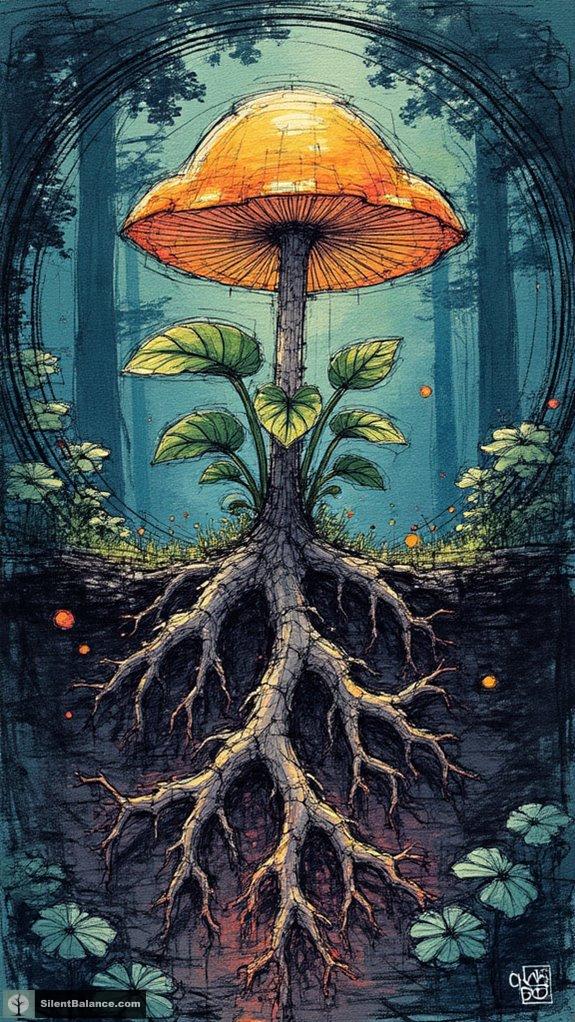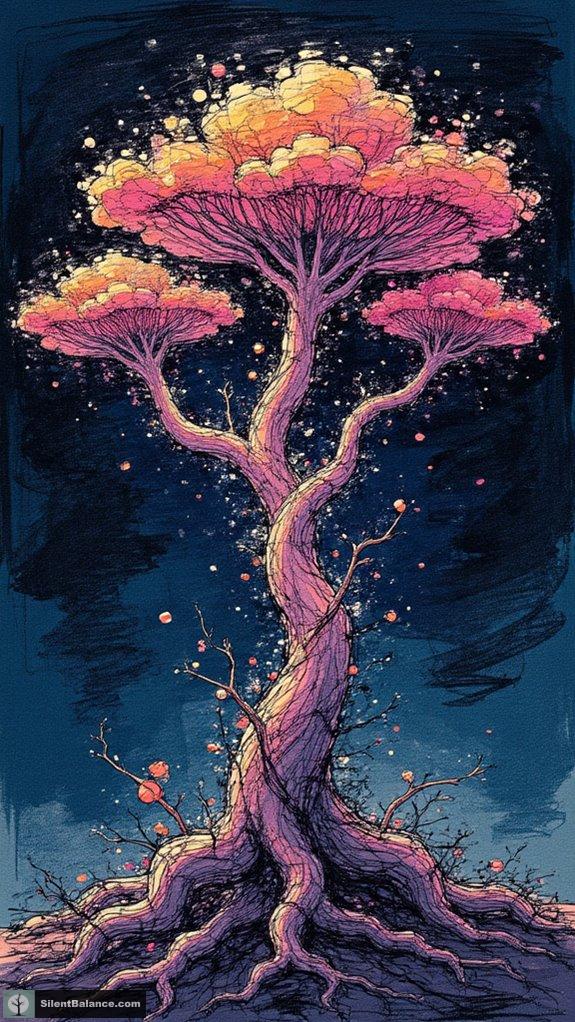Discovering the Fungal Web of Life
Curious about how fungi work their magic in nature? You’re in for a treat!
I remember wandering through an ancient forest, feeling dwarfed by towering trees. I stumbled upon a patch of mushrooms. It clicked. These fungi connect trees, sharing nutrients like a family potluck. Each tree plays a role, showcasing the symbolism of trees—strength, wisdom, and unity.
At Silent Balance, we dive into these networks, revealing their impact on biodiversity and ecological balance. Fungal networks are tacticians, warning their forest family of danger while promoting resilience.
One chilly evening, I watched my young daughter marvel at trees swaying in the wind. That warmth transformed into an understanding of their silent cooperation. It was a reminder—a true poetic thread that ties all life together, reinforcing our bond with nature’s wonders.
Quick Takeaways
- Mycorrhizal networks enable plants to share defense signals, demonstrating cooperative behavior in responding to threats from herbivores.
- Fungal networks facilitate decentralized resource transport, enhancing efficiency and collaboration among plants, reducing vulnerability to single points of failure.
- Trees exhibit kin recognition within fungal networks, prioritizing resource sharing with related individuals, showcasing a social structure that supports survival.
- Nutrient distribution through underground networks strengthens biodiversity by allowing diverse plant species to thrive and collaborate effectively.
- Mycorrhizal fungi enhance carbon sequestration significantly, showcasing their critical role in climate health through cooperative nutrient and carbon management.
Mycorrhizal Networks Enhance Inter-Plant Communication

When you think about how plants communicate, you might envision whimsical conversations happening in a hidden world below your feet—well, that’s fundamentally what’s going on with mycorrhizal networks!
These underground fungi act like a social network for plants, allowing them to swap essential information and chemical signals. This intricate system is sometimes referred to as the wood wide web, highlighting the vast interconnectedness among various plant species.
Envision plants sharing defense strategies, whispering about potential threats through specialized molecules. Ever heard of “tree talk”? That’s right; trees can rally each other to bolster defenses through this fungal highway. Additionally, these connections play a significant role in facilitating nutrient sharing among plants, enhancing their overall growth and resilience within their ecosystems.
And it’s not just about defense; they trade nutrients too! This connection shapes their survival, influences growth, and even affects local ecosystems.
The Role of Fungal Networks in Carbon Storage

You already know plants have their underground conversations thanks to those funky fungal networks, but let’s shift gears and talk about another key player in this hidden domain: carbon storage.
Did you know fungi are like the bouncers of the soil, holding onto roughly 86% of the microbial carbon? These networks anchor carbon in stable forms, thanks to their protective mineral coatings.
Fungi act as soil bouncers, securing about 86% of microbial carbon with their protective mineral coats.
Fungi love to team up with plants, swapping precious carbon for nutrients, fueling their underground empire.
Plus, healthy fungal communities can boost carbon storage by a whopping eight times compared to non-mycorrhizal areas. Fungal biomass accounts for 86% of total microbial biomass carbon in topsoil, making these networks indispensable for effective carbon sequestration.
Essentially, these fungal networks are your unsung heroes, stabilizing carbon and supporting the climate’s steady vibe.
Fungal Monitoring and Signaling for Plant Health

Fungal networks, often dubbed the underground command centers of our ecosystems, play an essential role in plant health that’s as complex as a well-inked tattoo.
These networks act like a secret communication line, warning connected plants of herbivore attacks. Ever wonder how those plants seem to coordinate their defenses? It’s all thanks to fungi signaling one another.
They’ve mastered the art of keeping their plant partners thriving, prioritizing those that transfer carbon like pros. Additionally, these networks enable the transfer of nutrients, enhancing the overall resilience and adaptive behaviors of plant communities. Furthermore, the presence of trees contributes to the chemical balance in the soil, further benefiting the health of these fungal networks.
And here’s the kicker: fungi seldom signal dishonestly; misleading a plant just isn’t their style.
This web of connections not only boosts plant resilience but also fosters biodiversity, proving that in this underground commune, cooperation rules the day, just like in a tight-knit tattoo crew!
Decentralized Resource Transport Through Fungal Networks

Visualize your local tattoo shop, where every artist has their own unique style, but ultimately they collaborate to create awesome pieces. Just like in that shop, fungal networks operate through decentralized resource transport, allowing each cord to contribute to the collective. Conceive how this teamwork boosts efficiency, avoiding the pitfalls of a single point of failure. This transport system reflects the principles seen in both animal and plant networks, ensuring the optimal distribution of resources to support the entire organism.
| Strategy | Connection Type | Efficiency Boost |
|---|---|---|
| Selective Allocation | Cords | High |
| Cross-Links | Redundant Edge | Robust |
| Minimum Spanning Tree | Unidirectional flow | Ideal Resource Use |
| Flexible Networks | Multidirectional Transport | Quick Adaptation |
Cooperative Nutrient Distribution and Its Impact on Biodiversity

While it mightn’t be as flashy as your favorite tattoo reel, the underground network of fungi works just as artfully to distribute nutrients among plants, creating vibrant ecosystems. These fungal connections, like the ink that binds a tat to your skin, keep diverse plant species hanging tight. When fungi share nutrients efficiently, they boost plant growth and resilience, helping them weather environmental storms. Less-related fungi can sometimes increase fungal network growth, but this may lead to reduced nutrient transfer to plants. Ever wonder how certain orchids pull carbon from neighboring plants? That’s the magic of these mycorrhizal networks!
But when competition kicks in, nutrient-sharing stumbles, threatening biodiversity.
Science of Cooperation Among Trees

Ever wonder how trees share secrets underground?
Through mycorrhizal networks, they’re constantly passing nutrients and warning signals to one another, creating a communal support system.
This tree-to-tree communication isn’t just a fancy tale; it’s an essential part of their survival strategy and a real game changer for ecosystems.
Mycorrhizal Networks Explained
Mycorrhizal networks (MNs) are like the underground social networks of the plant kingdom, where trees and other plants connect through a complex web of fungal hyphae, forming communication highways beneath our feet.
These fungal connections aren’t just for show—they’re essential for plant dialogue. Ever wonder how a stressed tree sends out a distress signal? Through MNs, its neighbors get the heads-up, gearing up defenses against herbivores before trouble strikes.
Imagine plants swapping secrets, adapting to their environment in real-time. They even influence who gets along in the community—talk about plant politics!
Nutrient Exchange Benefits
Think of fungal networks as the ultimate underground crew, hustling to keep their plant friends well-fed and thriving. These mycorrhizal fungi link plants together, sneakin’ essential nutrients like carbon, nitrogen, and phosphorus across species.
Ever hear about seedlings snagging up to 40% of their carbon budget through these connections? That’s some serious teamwork!
And it doesn’t stop there—plants with these hookups show off enhanced root and shoot growth, thanks to their fungal sidekicks.
They even adjust nutrient flow based on who’s nearby, flexing their roots just like artists calibrate their designs.
Tree Communication Methods
While you might think trees just stand silently in their spots, they’re actually chatting it up beneath the surface in ways that would impress even the most seasoned tattoo artists.
Trees communicate through chemical and electrical signals, thanks to their underground fungal networks—think of it like a nature-sized Instagram. They send out volatile organic compounds to warn neighbors of threats, while electrical signals travel like low-key whispers through the roots.
Here’s a quick breakdown:
| Method | Description |
|---|---|
| Chemical Signaling | Trees emit hormones to trigger defenses. |
| Electrical Signals | Fungal networks carry slow, pulsing messages. |
| Fungal Networks | Connect roots, facilitate nutrient sharing. |
Scientific Evidence of Mycorrhizal Tree Communication

In ecosystems, trees don’t just stand alone like silent sentinels; they chatter beneath the surface through elaborate networks that connect their roots.
These mycorrhizal networks, or MNs, create an information highway, linking trees of different species. It’s like a boisterous neighborhood gathering, where trees exchange carbon compounds, minerals, and even water, helping seedlings thrive in challenging conditions.
Ever wonder how trees alert each other to dangers? When one’s under attack, it sends out biochemical signals, like a tree-to-tree text message, ramping up defenses in its buddies.
Plus, it turns out trees recognize their kin, sharing resources preferentially. So, does that mean trees have family ties? You bet—and that communal vibe is essential to forest survival!
Questions and Answers
How Do Fungal Networks Influence Plant Behavior During Drought Conditions?
Have you ever thought about how fungal networks totally influence plant behavior during drought?
These underground connections act like VIP passes, hooking plants up with water and nutrients, ensuring survival.
Some fungi help plants save moisture, while others might cause a bit of wilt, kinda like the bad influence you don’t need.
Still, together, they create a community that’s all about sharing resources—making sure every green buddy gets through tough times.
Pretty rad, huh?
Can Fungal Networks Improve Agricultural Practices and Crop Yields?
Did you know that plants linked to fungal networks can boost crop yields by up to 30%?
Imagine harnessing the power of nature to elevate your farm game. Mycorrhizal fungi not only help plants absorb nutrients like a champ, but they also pump up resilience against stress.
What Role Do Fungal Networks Play in Forest Fire Recovery?
Fungal networks play an essential role in forest fire recovery, so it’s like having a squad ready to rebuild after the chaos.
They boost nutrient uptake and water exchange, which are critical for young seedlings to thrive. You might think of them as nature’s unsung heroes, quietly patching things up.
Without these mycorrhizal fungi, you’d see sluggish recovery and struggling ecosystems.
They’re the real MVPs in getting our forests back on track after the flames.
How Do Different Fungi Affect Network Efficiency and Plant Cooperation?
Fungi are like the underground tattoo artists of the plant world, crafting connections that make cooperation a masterpiece!
Different fungi, like ecto and arbuscular types, shape root structures, ensuring plants share nutrients effortlessly.
You ever wonder how plants “talk” through these networks? They adjust their growth and defense based on what their fungal homies signal.
It’s a wild collaboration, turning individual survival into a vibrant community vibe, maximizing efficiency in every soil-filled corner!
Are Fungal Networks More Beneficial for Certain Plant Species Than Others?
You’ve got to wonder, right? Are these fungal networks really more beneficial to certain plant species?
Absolutely! Some plants thrive on partnerships with specific fungi. Picture a fresh tattoo, tailored just for you—those plants get that kind of personalized nutrient boost!
With AM fungi, you’ve got a diverse crew supporting various floral friends, while EM fungi play favorites, favoring select plant buddies.
In the end, it’s all about finding the right match—just like in life!
Summary
So, there you have it—nature’s underground network is as complex as a tattoo sleeve, blending colors and stories into a masterpiece. Mycorrhizal networks not only spice up inter-plant chit-chat but also play an essential role in keeping ecosystems thriving. Isn’t it mind-blowing how these fungi work behind the scenes, like artists crafting their next big piece? Next time you see a tree, recall, it’s connected to a vibrant community, streaming nutrients like they’re sharing secrets. How cool is that?
References
- https://pmc.ncbi.nlm.nih.gov/articles/PMC4497361/
- https://www.princeton.edu/news/2025/03/25/research-reveals-underground-traffic-between-fungi-and-plants
- https://www.pnas.org/doi/10.1073/pnas.2420701122
- https://phys.org/news/2025-02-scientists-robot-track-fungal-networks.html
- https://www.nationalforests.org/blog/underground-mycorrhizal-network
- https://pmc.ncbi.nlm.nih.gov/articles/PMC11020090/
- https://www.frontiersin.org/journals/fungal-biology/articles/10.3389/ffunb.2021.735299/full
- https://digitalcommons.lindenwood.edu/cgi/viewcontent.cgi?article=1009&context=theconfluence
- https://scienceblog.com/hidden-champions-how-underground-fungal-networks-lock-away-carbon-for-thousands-of-years/
- https://www.spun.earth/networks/climate
- https://www.indogulfbioag.com/post/carbon-sequestration-and-mycorrhizae
- https://www.nature.com/articles/s41467-024-46792-w
- https://pmc.ncbi.nlm.nih.gov/articles/PMC12106282/
- https://apsjournals.apsnet.org/doi/10.1094/PHYTO-10-22-0370-KD
- https://pubmed.ncbi.nlm.nih.gov/39835901/
- https://pmc.ncbi.nlm.nih.gov/articles/PMC2288531/
- https://www.nature.com/articles/s43705-021-00085-1
- https://www.zoology.ubc.ca/bdg/pdfs_bdg/2015 Spring/Simard et al. 2012.pdf
- https://pmc.ncbi.nlm.nih.gov/articles/PMC11687498/
- https://besjournals.onlinelibrary.wiley.com/doi/full/10.1111/1365-2435.14545
- Bonsai Placement Benefits for Room Harmony - November 8, 2025
- Why Use Air Layering to Propagate Bonsai Trees? - November 8, 2025
- 15 Stunning Acorn Wood Wall Art Ideas - November 8, 2025

